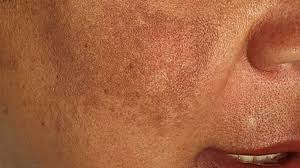Pigmentation on Face

Causes of hyperpigmentation
The cause of hyperpigmentation depends on the type. The most common causes of hyperpigmentation are:
Sun exposure
The body produces more melanin to protect the skin from prolonged exposure to the sun. This can cause dark
spots or patches on the skin called age spots or sun spots.
Skin inflammation
Areas of skin can darken after people have had inflammation of the skin. This can include acne, eczema, lupus,
or an injury to the skin. People with darker skin are more likely to develop post-inflammatory hyperpigmentation.
Melasma
Darker patches of skin can form when people experience hormonal changes. This type of hyperpigmentation is
common during pregnancy.
Reactions to drug use :-Certain medications, such as antimalarial drugs and tricyclic antidepressants, can
cause hyperpigmentation. In these cases, patches of skin may turn gray.
Chemicals in topical treatments can also sometimes cause hyperpigmentation.

Medical conditions
More serious causes of hyperpigmentation include Addison’s disease and hemochromatosis.
Addison’s disease affects the adrenal glands. It can cause hyperpigmentation in certain areas of the body,
including:
● folds of skin
● lips
● elbows and knees
● knuckles
● toes
● inside of the cheek
Other symptoms of Addison’s disease include:
● fatigue and weak muscles
● nausea
● vomiting and diarrhea
● weight loss
● stomach pain
● dizziness
A person should see their doctor if they notice any of these symptoms.
Hemochromatosis is an inherited condition that causes the body to contain too much iron. It can cause
hyperpigmentation, making the skin appear darker or tanned.
A person should see their doctor if they notice the following symptoms of hemochromatosis:
● fatigue
● stomach pain
● joint pain
● weight loss
Hyperpigmentation and melasma
Melasma is a type of hyperpigmentation. Melasma usually covers a larger area of skin than other types of
hyperpigmentation, and it usually appears on the face.
Melasma mostly affects women, affecting men just 10 percent of the time. Other types of hyperpigmentation
affect men and women equally. Melasma is more common in people with darker skin and may run in the family.
Doctors are still unsure about what causes melasma, but a change in hormones can sometimes trigger it.
Pregnancy and taking birth control pills can both cause melasma. Doctors sometimes call melasma the “mask of
pregnancy,” as it can cause darker skin on the face. When a person is no longer pregnant, or they stop taking
birth control pills, the melasma usually disappears.
Melasma can disappear on its own, but without treatment, it may not. People can fade or reduce melasma in the
same ways as they would other types of hyperpigmentation.

Diagnosis
People with hyperpigmentation can see a doctor, who will be able to identify the type and cause. A doctor may
take a small sample of skin, or a biopsy, to determine the cause of the hyperpigmentation.
Doctors can usually diagnose melasma and other types of hyperpigmentation just by looking at the skin. They
may sometimes use a special light called a Wood’s light to examine the skin.
A doctor or dermatologist will then be able to create a treatment plan if necessary.
Summary
Hyperpigmentation is a common skin condition that can affect many people for many reasons. Types of
hyperpigmentation include age spots, melasma, and post-inflammatory hyperpigmentation.
Hyperpigmentation is a harmless skin condition that people can get rid of using removal techniques such as
cosmetic treatments, creams, and home remedies.
If a person notices other symptoms alongside hyperpigmentation, they should seek advice from their doctor.
If a person wants to treat hyperpigmentation for cosmetic reasons, they can seek advice from a dermatologist,
who will be able to advise them on the best treatment methods available





